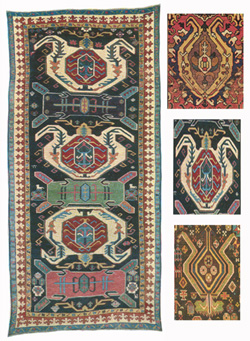In the Versions of the Egg Palmette thread, Steve questioned whether the Lenkoran medallion followed the egg palmette historically, as possibly suggested by Daniel's first panel of four images. While we can't establish the precise chronology, I believe that Daniel's placement of the Lenkoran medallion after the egg palmette reflects their sequential development. The Lenkoran medallion seems to simply be a flattened egg palmette.
Both Steve and Daniel agreed that the Lenkoran medallion does not predate 1850, but there is evidence to the contrary. Orient Stars plate 11 attributes to the Southeast Caucasus and to the 18th Century a rug with medallions and bars that we would all willingly call Lenkoran. It clearly is much older than the Lenkoran in Daniel's four-image panel (a late 19th Century piece).

In his Caucasian Rugs, plate 57, Schurmann attributes a handsome Lenkoran to the 18th Century. This may be aggressive dating, but it also seems to predate the last quarter of the 19th Century. Here I show that Lenkoran along with an egg palmette, the Italian palmette and a narrowed version of the Lenkoran medallion. The conclusion seems inescapable that the egg palmette and the Lenkoran medallion are generational cousins. (It is curious that even the oldest Lenkoran medallions are usually compressed rather than elongated.)

This rug may provide another explanation for the serrated pendant on the Italian palmette. Are the "bars" on the Lenkorans vestiges of the bands from the dragon rugs? It is quite possible.
It would be good to know the structure and handle of the Orient Stars Lenkoran. Generally speaking, Lenkoran medallions are found only in what we today generically call Caucasian rugs (those well known collectibles from the 19th Century), but not in Classical Caucasian rugs, which have a distinctive structure and handle. Is the Orient Stars Lenkoran a Classical Caucasian rug? By the manner in which it is cataloged, one might think not.
On a final note, I can't recall seeing anything in a Salor ensi that really looks like a Lenkoran medallion but John's posting of the Hecksher eagle-gul main carpet indicates that we can look far and wide for adaptations of this type of motif.
Wendel